
MediaTek is ready to enter the flagship Android phone race and challenge Qualcomm’s Snapdragon 8 Gen 3 with its latest processor. The Taiwanese company’s latest weapon is the MediaTek Dimensity 9300, which is based on the 4nm process and packs a cluster of four top-tier ARM cores, putting in a position to race ahead via brute performance.
Compared to its direct rival from Qualcomm (which only has one large prime core), the MediaTek chip goes with an even more ambitious core configuration. There are four ARM Cortex-X4 cores, one of which goes up to 3.25 GHz, while the other three are clocked at 2.85 GHz. For less demanding tasks, there’s a cluster of Arm Cortex-A710 cores.
That large core cluster flexes its might on synthetic benchmarks, with MediaTek claiming nearly double the performance on the Geekbench 6 test and an astounding tally of over 213,000 on the AnTuTu platform. On gaming-centric tests such as GFXBench, the company claims an even bigger lead.
The Dimensity 9300 can support screens maxing out at a 180Hz refresh rate, while 4K panels can refresh at up to the 120Hz mark. On the connectivity front, Wi-Fi 7 is part of the package. There’s also a dedicated security chip in place for securely booting the OS.

On the AI-specific innovation front, MediaTek’s latest flagship mobile processor comes with an AI engine that doubles the AI performance at certain metrics while also consuming 45% less energy. Dubbed APU 790, MediaTek claims it is eight times faster than its predecessor and can produce visual media in less than a second using Stable Diffusion’s text-to-image models.
The company has also tweaked the memory architecture and claims that it can run large language models with up to 13 billion parameters, “with scalability up to 33 billion.” For comparison, Qualcomm’s latest and greatest Snapdragon 8 Gen 3 can only run AI models with up to 10 billion parameters.
Just like its Qualcomm counterpart, MediaTek’s offering also supports mainstream multimodal large language models such as Meta’s Llama 2 and Baidu LLM, among others. But the focus is once again clear. MediaTek is following Qualcomm straight into the race for generative AI tasks covering text, visual media, and audio generation. With another chip company doubling down on AI, this could be even worse news for Google’s Pixel phones.
On the graphics front, the Dimensity 9300 relies on the new 12-core Immortalis-G720 GPU, which is said to be 46% faster and 40% more frugal at power consumption. MediaTek is also banking on gaming-centric perks like hardware-accelerated ray tracing that are touted to deliver a 60 frames-per-second (fps) gaming experience with console-grade lighting effects.

The image signal processor allows 4K HDR capture at up to 60 fps and real-time bokeh tracking in
MediaTek says the first phones powered by the Dimensity 9300 will arrive later this year. This time around, MediaTek seems to surpass Qualcomm at raw firepower, as well as a willingness to embrace AI chops that are all the rage these days. It would be interesting to see how many brands pick MediaTek over Qualcomm in 2024, and whether it can finally even the gulf when it comes to customer preference.
Editors' Recommendations
- Motorola’s new Android phone looks amazing, but there’s a catch
- This company just announced lots of new Android phones, and they look great
- The secret cost of adding AI to your smartphone
- Your Android phone just got an update that could save your life
- One of 2023’s most interesting Android phones just dropped




